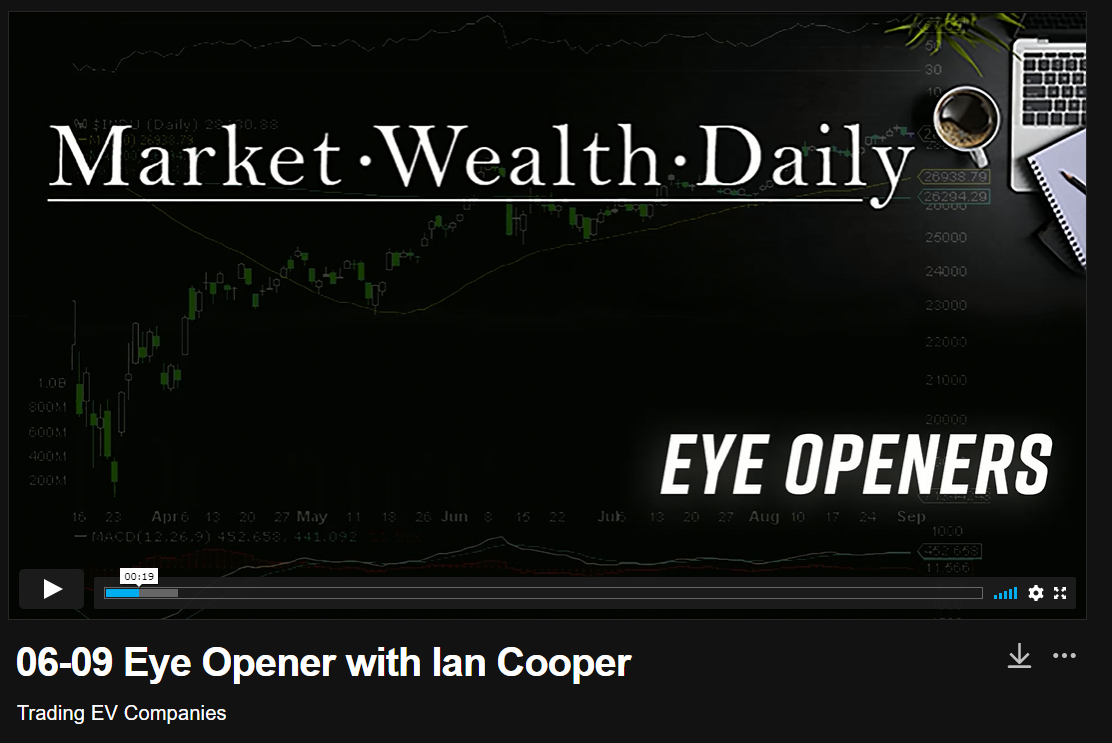
This past week investors saw the markets build on strength from the prior week. All three major market indices posted new all-time highs with the Dow closing above 40K for the first time ever. While the headline S&P 500 index had a strong week as it made numerous new highs, the story was really more about the Equal Weighted S&P 500 index which finished the week up 2.9% and approaching its all-time high. Additionally, the Russell 2000 posted a strong performance as the small call index rose 6.11% on the week. Last week’s bullish expansion was fueled by a cooler than expected CPI inflation report combined with quite dovish commentary from Fed Chair Powell, which the markets interpreted as him setting the foundation for the soon-to-begin rate cutting cycle. This growing confidence that the first cut will likely be occurring soon led investors to take profits in some stocks that have been the top winners in the market this year and redeploy this cash into stocks that will benefit in an environment where rates are coming down. Now, our top market-leading stocks from this year still had a strong week as overall many of them still finished the week higher, but this rotation and redeploying of profits into other sectors, which have lagged, is what caused the Equal Weight S&P 500 & Russell 2000 to outperform last week. In conjunction with the market rotation we witnessed last week, the bull market in general also displayed some broadening out as well. Looking at the NYSE Advance Decline Index, this index scorched higher, making news highs. Additionally, now roughly 72% of S&P 500 stocks are trading above their 200-Day moving average, signaling a longer term uptrend. Each of these benchmarks are indicators of strong breadth across the market. Since more than two-thirds of S&P 500 stocks are in long-term uptrends, the health of this bull market is strong. Now, at these levels, we are not quite yet at short-term overbought status for the S&P 500, however, we are approaching it. If the percentage of S&P 500 stocks trading above their 50-Day moving average moves into the mid 70’s, this would be a point where we expect the market to look to take a breather. Furthermore, the S&P 500 has climbed in 5 of the last 6 weeks, so if we post another gain this week, we expect for the index to likely cool down for a week or two.
This week will bring us a fresh batch of economic data including the latest U.S. Retail Sales data. This week’s economic data however is going to be very homebuilding centric as we will get the new HMI Index number as well as the June Housing Starts & Building Permits reports for the U.S. On the back of last week’s big move for homebuilding related stocks, as this week’s data comes in it will be crucial for the sustainability of these moves. This week will feature a few FOMC member speaking engagements before members enter their quiet period leading up to the July meeting. We expect these Fed speakers to reinforce and stick to the messaging that has been laid out by Fed Chair Powell. Finally, we are now getting into the thick of Q2 earnings season this week. The large-cap U.S. Financials will continue to report their earnings toward the beginning of the week when we hear from major banks like Goldman Sachs Group, Inc. & Morgan Stanley. Then towards the end of the week we will wrap things up when we get earnings numbers from major tech firms like Netflix, Inc.
- U.S. Retail Sales – On Tuesday, the U.S. Census Bureau will reveal their monthly retails sales report. The U.S. Retail Sales report serves to quantify the total that U.S. consumers spent on both durable & non-durable goods. This report is a key piece of macroeconomic data as retail sales are an important measuring stick for the health of the U.S. economy. This indicator carries a heavier weight compared to consumer surveys as this indicator reflects what consumers ‘are actually doing’ vs. what they are saying in a survey.
- Retail Sales for June are expected to not post an increase but rather remain flat. This would follow May’s report where sales grew month-over-month by 0.1%.
- Home Builder Confidence Index (HMI) – On Tuesday, we will get the HMI report for the month of July. The HMI report serves as a confidence gauge for the U.S. home builder industry. After rising to begin the year, the HMI index has fallen over the past two months. As rates have begun to relax, should this continue over the coming months, expect this index to begin to trend higher again.
- The consensus prediction for July is that the HMI index will come in at 44. This would be a slight increase over June’s number, reflecting that the recent decline was likely due to interest rates hitting a short term high in late-April to early May. As rates have relaxed, we could see an upside surprise here.
- Housing Starts & Building Permits – Following Tuesday’s HMI report, on Wednesday morning, investors will get the latest reads from the Census Bureau on new housing starts as well as new building permits issued in the month of June. This data is significant as it reflects how much work U.S. home builders currently have scheduled. Additionally, it can provide helpful information about the current state of the economy and the consumer’s appetite for spending on large purchases such as housing.
- New Housing Starts & Building Permits for June are expected to come in at 1.31 million & 1.39 million respectively.

Federal Reserve Watch
This past week, Fed Chair Powell had two appearances in front of Congress to address the state of inflation and employment in the nation. After watching these engagements, many investors came away with the thought that Chair Powell has begun laying the groundwork for the first policy rate cut, likely in September. Chair Powell acknowledged that there has been significant progress on bringing inflation back down to the FOMC’s goal of 2.0% and also that the committee is well aware of the double sided risks related to leaving the Fed Funds rate at an elevated level. This acknowledgement was perceived by investors that Powell and the committee are aware of the downside risk of leaving rates too high for too long and that this is in the forefront of their minds, and it now is a greater concern for them than inflation creeping back up. Powell stated that he and FOMC members want to see a few more positive inflation reports before enacting the first rate cut. Essentially, Powell was telegraphing that if the next two PCE inflation reports continue to show strong progress on inflation, that the committee is prepared to cut at the September meeting.
- Towards the end of this month, when the next FOMC meeting is scheduled, there is still little expectation that the Fed will opt to reduce rates at this meeting. Given this past week’s developments combined with recent economic data beginning to show mild weakness and inflation reports consistently coming in cooler than expected, markets are all but convinced that the ‘Soft Landing’ narrative is going to come to fruition and the first rate cut is coming soon. Since there is little expectation that the cutting cycle will begin later this month at the July meeting, let’s look beyond this meeting, on to the final three meetings of the year. After the market close on Friday, the CME FedWatch tool shows that investors are now placing a 94.4% probability of a rate cut occurring in September, kicking off the rate cutting cycle. Looking at current Fed Funds futures, investors feel we will end the year with the Fed’s policy rate in the range of 4.75%-5.00% which would be 50 basis points lower than status quo. This indicates that at present the market is anticipating two rate cuts this year, however, with recent developments, Fed Funds futures are not far from indicating that investors are betting on three rates cuts before years end. Only a slight movement in the futures markets and this would be the case. So, three rate cuts this year is beginning to look like it may be back in play. At market close on Friday, Fed Futures odds for the November & December meetings show that markets are pricing in the likelihood of a rate cut at 97.7% & 99.9% respectively.
This Week’s Notable Earnings
This week, Q2 earnings will really begin to ramp up as the remainder of the major ‘Financials’ will continue to post their quarterly results. The major Financials that are expected to report this week are Goldman Sachs Group, Inc., Morgan Stanley, Bank of America Corp., & Blackrock, Inc. Following this group, we will also get the first peek at Q2 semiconductor earnings as both ASML Holdings & Taiwan Semiconductor Mfg. will post their results. Finally, the last company due to report this week that we want to draw your attention to is the top streaming company, Netflix, Inc.
- Following last week’s kickoff of the major ‘Financial’ earnings, this event will continue this week as investors will hear from the likes of Goldman Sachs Group, Inc., Morgan Stanley, Bank of America Corp., & Blackrock, Inc. on Monday and Tuesday. GS, MS, & BLK are all forecast to report strong earnings growth. Analysts are expecting GS to post a whopping 171.1% YoY increase in the Q2 earnings. However, BAC is anticipated to post a slight YoY decline in their Q2 earnings.
- GS earnings are expected to come in at $8.35 EPS.
- MS earnings are expected to come in at $1.65 EPS.
- BAC earnings are expected to come in at $0.80 EPS.
- BLK earnings are expected to come in at $9.93 EPS.
- This week we will get the first few of the major semiconductor-related earnings reports when ASML Holding & Taiwan Semiconductor Mfg. report on Wednesday and Thursday respectively. Each of these companies play a major role in the production of high end semiconductors which are at the heart of the A.I. related rally. ASML is forecast to post a decline in Q2 earnings while analysts expect TSM to report YoY growth of 21.9% in their Q2 results.
- ASML earnings are expected to come in at $3.73 EPS.
- TSM earnings are expected to come in at $1.39 EPS.
- On Thursday after the closing bell, investors will hear from the streaming giant, Netflix, Inc. when they are slated to report their Q2 earnings. NFLX has been a strong performer this year thus far and analysts expect them to post a 44.4% YoY growth rate in their Q2 earnings. If NFLX can deliver on earnings and guidance, expect this report to help propel the stock to further new highs.
- NFLX earnings are expected to come in at $4.75 EPS.
Thank you for reading this week’s edition of the Weekly Market Periscope Newsletter, I hope you enjoyed it. Please lookout out for the next edition of the newsletter as we will give you a preview of the upcoming week’s important market events.
Thanks,

Blane Markham
Author, Weekly Market Periscope
Hughes Optioneering Team












Recent Comments